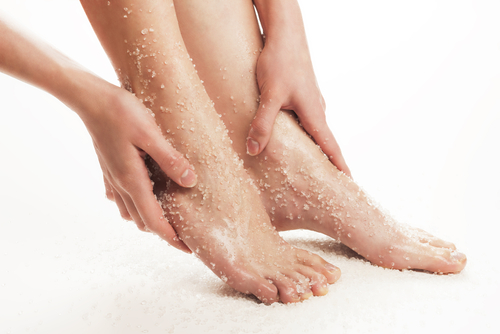Summertime is drawing near, are your feet ready to hit the beach? During winter months, it is natural for the cold weather to help create dry feet and cracked heels. In addition, ladies (and some gents) may skip pedicure maintenance because their feet are less exposed. Flip flop season is here again, so let’s take a look at how to get your feet ready below:
Dry, Cracked Heels
-
Not wearing socks on hardwood and/or cement floors
-
Cold, dry weather
-
Too much time in the sun
-
Not properly moisturizing
-
Using harsh soaps and detergents

Directions for Vinegar Soak
-
Draw lukewarm bath tub 1/2 full
-
Add 3-4 cups of vinegar to optimize the water’s pH
-
Soak feet 12-15 minutes
-
Use a pumice stone to remove dry flakes and dead skin cells (especially on the balls of the feet)
-
Moisturize 3-5 minutes after the soak with a petroleum based ointment and ceramide cream
Toenail Tips
Pedicures are necessary for maintaining nail health. Be careful about where you go to receive pedicures, if you choose to have them professionally done. Dirty water and unclean tools can lead to infection. If you choose to do your own pedicure, here are some helpful tips for ensuring proper maintenance:
-
Use nail scissors to remove hanging skin around the toenail. Do not cut the cuticles. This poses risk for infection.
-
Push back cuticles with an angle tipped nail stick. Use a cuticle remover to soften them, prior to pushing them back.
-
For natural nails, use a nail file with a 180 grit for shortening nails.
-
Avoid metal nail files if your nails are weak, or thin. They can be too rough.
-
Use a buffing block to buff a natural shine on your toenails.
-
Always sterilize metal pedicure tools and replace others every couple months. This will help prevent fungi and infection from breeding and spreading. Don’t share pedicure tools.
For nail discoloration, take a lemon wedge and rub the nails with it for one minute. Lemons contain oxidizing agents that will help to brighten discolored nails! If this naturopathic remedy doesn’t help with the discoloration, you may have a fungal infection. See a doctor for other treatment options.
Dr, Cheryl Lee Eberting blogs regularly about skin problems, treatment and after care.




